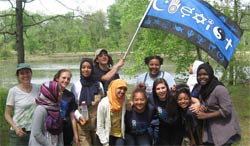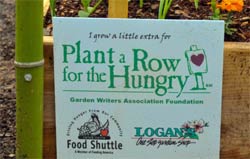By Sana Saeed
GREENING YOUR CONGREGATION AND YOUR LIFE
Happy New Year! While everyone is still thinking about New Year’s resolutions, why not consider making 2013 the year you reduce your carbon footprint and help the community at large by planting a sustainable vegetable garden.
Below are five interfaith organizations and resources that can guide you in making some green changes around your home and in your house of worship.

- GreenFaith – GreenFaith's mission is to inspire, educate, and mobilize people of diverse religious backgrounds for environmental leadership. It aims to help individuals and religious leaders understand that protecting the environment is a religious obligation. Take a look at GreenFaith's religious teachings section, a list of Christian, Hindu, Islamic, Buddhist, and Jewish literature that speaks out on behalf of the environment.
- Especially useful are GreenFaith's start up kits for beginning to renew your house of worship or individual space into a green environment. The kits list three easy first steps to becoming green as an individual such as making a vegetarian dinner today or turning your thermometer down by 1 degree! Additionally the GreenFaith site has a list of issues and action kits through which you can browse if you want to pursue environmental advocacy through a faith perspective.

- Interfaith Power and Light – The mission of IPL is to be faithful stewards of creation by responding to global warming through the promotion of energy conservation, energy efficiency, and renewable energy. Its upcoming action project is a national “Preach-In” February 8-10th, and on the website you can order a Preach-In kit to start mobilizing your religious community to prepare for the action. IPL's website also provides sample sermons with lots of ideas for ministers and lay leaders. These sermons are written by Islamic, Jewish, Christian, Baha’i, and Buddhist leaders.
- Another resource IPL provides lay leaders and community organizers is a list of study guides. The one free study guide, Scientific and Spiritual Dimensions of Climate Change, is particularly helpful. It is written from a Baha’i perspective but with interfaith participants in mind. The group study is set up for 9 classes of about 2 hours each, a good way to bring your religious or interfaith community together to learn about climate change.

- Interfaith Youth for Climate Justice – IYCJ’s mission is to contribute to a more just and sustainable society by empowering a new generation of diverse youth inspired by their faiths to lead the environmental movement. The year-long program is free and for students active in local congregations in the Washington DC, Maryland, and Virginia areas. IYCJ provides three retreats each year, monthly meetings, and paid internships over the summer for youth. Check out IYCJ's teaching model, and if you know of any teens in this region pass on the application to them.

- Green Muslims – Green Muslims seek to emphasize the responsibility of environmental stewardship in American Muslim communities by building partnerships with a spectrum of organizations and interfaith communities. Consider throwing an interfaith Iftar potluck during Ramadan to get to know your Muslim neighbors. Green Muslims provides a guide to hosting a Green Iftar. Another resource provided by Green Muslims that everyone can use is the No Impact Guide, with a challenge to reduce your carbon footprint in just seven days!

- Inter-Faith Food Shuttle – Inter-Faith Food Shuttle pioneers innovative, transformative solutions designed to end hunger in local communities. The Plant a Row resource provided on its website is an excellent way to practice being green in 2013 and help alleviate hunger in your community. Plant a vegetable row in your yard, then donate the produce to your local interfaith shelter.
Why gardening? According to Inter-Faith Food Shuttle, approximately 30.3% of children ages 6 to 11 are overweight and15.3% areobese; and studies show a link between food insecurity and obesity. Gardening provides physical activity, stress relief, family bonding, community building, and, most importantly, fresh food. Think about growing vegetables in your yard or in a local community garden and then organizing a delivery to a nearby shelter.
These resources are just a starting point for learning about going green and what diverse faith traditions say about our responsibility for our environments. Think about getting in touch with some of the organizations listed above to implement some of the programs in your community.
If you know of any another resources and ideas around interfaith environmental sustainability in local communities, please feel free to email me at resources@theinterfaithobserver.org – I’d be happy to share them on the TIO Facebook Page.

